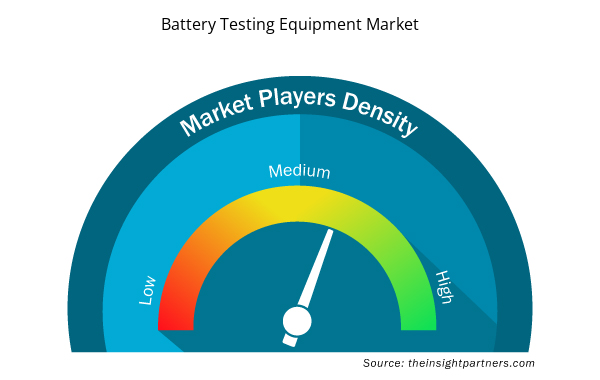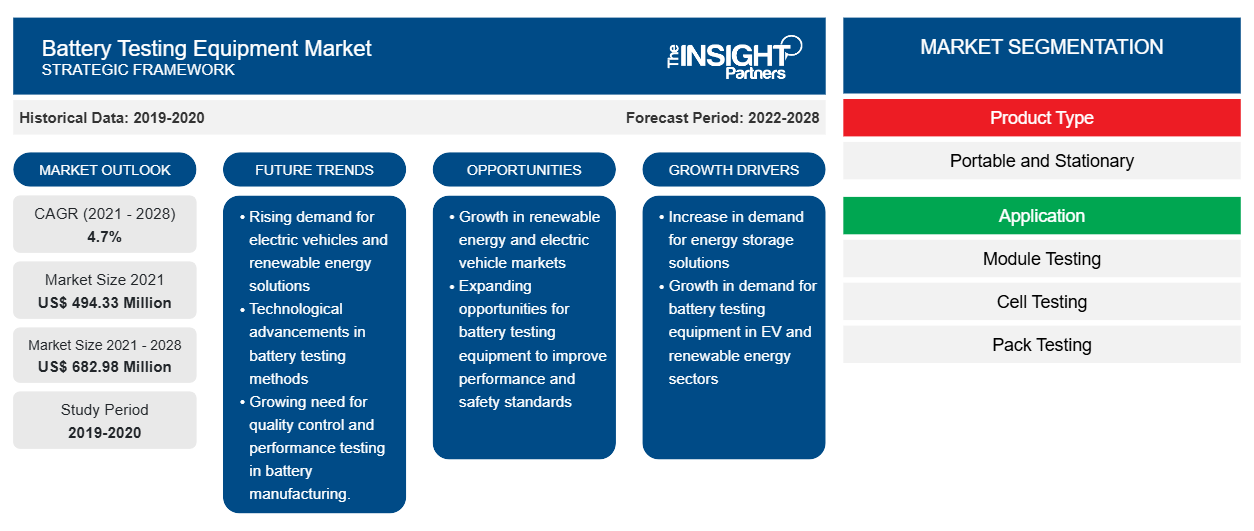2021 年电池测试设备市场价值为 4.9433 亿美元,预计到 2028 年将达到 6.8298 亿美元;预计 2021 年至 2028 年的复合年增长率为 4.7%。
航空航天和国防、汽车和医疗保健等行业正在大力投资先进技术,以利用先进机械增强其能力并为客户提供更好的服务。美国、法国、瑞典、英国和其他国家的公司正在为其全球客户开发先进的电池测试设备。美国陆军对先进电池的采购不断增加也支持了市场的增长。此外,eVTOL的发展以及德国、阿联酋和新加坡等国家政府为发展城市空中交通基础设施而采取的举措预计将推动电池测试设备市场参与者的增长。
预计未来几年,美国、中国、印度等国国防开支的增加将推动电池测试设备市场的增长。由于与邻国边境冲突不断增加,印度、中国和印度尼西亚等发展中国家将重点加强军事能力。中国和印度等国制造业的不断扩张将进一步推动电池测试设备市场的增长。
定制此报告以满足您的需求
您可以免费定制任何报告,包括本报告的部分内容、国家级分析、Excel 数据包,以及为初创企业和大学提供优惠和折扣
- 获取此报告的关键市场趋势。这个免费样品将包括数据分析,从市场趋势到估计和预测。
COVID-19 疫情对北美电池测试设备市场增长的影响
美国是北美受疫情影响最严重的国家,许多制造工厂要么暂时关闭,要么以最低限度的人员运营,零部件供应链中断,这些都是北美制造商面临的关键问题。
由于美国拥有大量的电池测试设备、零部件制造商和行业,疫情爆发严重影响了每个生产和创收。制造人员数量减少导致生产量减少。另一方面,原材料供应有限和航空航天业关闭也影响了美国的电池测试设备市场。然而,该国不断增加的军费开支以及特斯拉等公司对电动汽车的不断发展预计将在不久的将来为电池测试设备市场参与者提供增长机会。
市场洞察 – 电池测试设备市场
不断增长的交通需求推动
由于中国、印度、韩国等发展中经济体人民的可支配收入不断增加,对汽车的需求也随之增加。根据印度汽车制造商协会 (SIAM) 的数据,从 2019 年 9 月到 2020 年 9 月,印度的乘用车销量增长了 26.45%。知名汽车制造公司增加投资以及亚太地区政府对汽车制造的有利规范等因素预计将推动该地区电池测试设备市场的增长。此外,越南等国家政府为扩大汽车工业而采取的举措也有望推动电池测试设备市场规模的增长。
基于产品类型的洞察
根据产品类型,电池测试设备市场细分为便携式电池测试设备和固定式电池测试设备。固定式电池测试设备部门在 2020 年以 54.1% 的市场份额领先于电池测试设备市场。固定式电池测试是在电池为新电池时进行容量测试,作为验收测试的一部分,进行阻抗测试以确定电池的基线值,并在 2 年内重复上述测试过程以保证电池的保修。测试过程每季度检查一次阀控铅酸 (VRLA) 电池的阻抗,并在预期使用寿命每达到 25% 时进行容量测试。
基于应用的洞察
根据应用,电池测试设备市场细分为模块测试、电池测试和电池组测试。电池测试部分在 2020 年引领了市场。电池压力测试用于评估对电气、环境和机械压力等的响应。电池测试可延长电池寿命并模拟复杂的真实测试配置文件。此外,电池测试仪专为对锂离子电池、电双层电容器 (EDLC) 和锂离子电容器 (LIC) 进行测试而设计。预计这将扩大电池测试设备市场规模。
根据地域,电池测试设备市场分为五个主要区域,即北美、欧洲、亚太地区、中东和非洲以及南美。2020 年,北美占据最大的收入份额,其次是欧洲和亚太地区。预计 2020 年至 2028 年,亚太地区的市场将以 5.8% 的复合年增长率增长。Arbin Instruments、Century Yuasa Batteries Pty Ltd.、Chauvin Arnoux、Chroma Systems Solutions, Inc.、DV Power、Extech Instruments、Megger、Midtronics, Inc.、Storage Battery Systems, LLC 和厦门 Tmax Battery Equipments Limited 是本次市场研究中介绍的生态系统中的关键参与者。
电池测试设备市场区域洞察
Insight Partners 的分析师已详尽解释了预测期内影响电池测试设备市场的区域趋势和因素。本节还讨论了北美、欧洲、亚太地区、中东和非洲以及南美和中美洲的电池测试设备市场细分和地理位置。

- 获取电池测试设备市场的区域特定数据
电池测试设备市场报告范围
| 报告属性 | 细节 |
|---|---|
| 2021 年市场规模 | 4.9433亿美元 |
| 2028 年市场规模 | 6.8298亿美元 |
| 全球复合年增长率(2021 - 2028) | 4.7% |
| 史料 | 2019-2020 |
| 预测期 | 2022-2028 |
| 涵盖的领域 | 按产品类型
|
| 覆盖地区和国家 | 北美
|
| 市场领导者和主要公司简介 |
|
电池测试设备市场参与者密度:了解其对业务动态的影响
电池测试设备市场正在快速增长,这得益于终端用户需求的不断增长,而这些需求又源于消费者偏好的不断变化、技术进步以及对产品优势的认识不断提高等因素。随着需求的增加,企业正在扩大其产品范围,进行创新以满足消费者的需求,并利用新兴趋势,从而进一步推动市场增长。
市场参与者密度是指在特定市场或行业内运营的企业或公司的分布情况。它表明在给定市场空间中,相对于其规模或总市场价值,有多少竞争对手(市场参与者)存在。
在电池测试设备市场运营的主要公司有:
- 阿尔宾仪器公司
- Chroma 系统解决方案有限公司
- 阿美特克科学仪器
- 生物
- Bitrode 公司
免责声明:上面列出的公司没有按照任何特定顺序排列。

- 了解电池测试设备市场主要参与者概况
电池测试设备市场的参与者主要专注于开发先进、高效的产品和合作。
- 2021 年,是德科技公司 (Keysight Technologies, Inc.) 与 Proventia Oy 合作改进电动汽车 (EV) 电池测试解决方案。
- 2021 年,Chroma 推出了一款 E-Scooter 快速充电测试系统,以帮助 CHAdeMO 协会检查电动汽车充电接口刺激器。随着电动汽车行业的国际增长,它还将帮助定义两轮电动汽车快速充电测试标准的协议检查表。
- 历史分析(2 年)、基准年、预测(7 年)及复合年增长率
- PEST 和 SWOT 分析
- 市场规模价值/数量 - 全球、区域、国家
- 行业和竞争格局
- Excel 数据集



Report Coverage
Revenue forecast, Company Analysis, Industry landscape, Growth factors, and Trends

Segment Covered
This text is related
to segments covered.

Regional Scope
North America, Europe, Asia Pacific, Middle East & Africa, South & Central America

Country Scope
This text is related
to country scope.
常见问题
The Animatronics is the process of manufacturing and operating lifelike robots that are used for entertainment or films; whereas, robotics is the process of designing, constructing, and operating robots. Batteries are used in these systems as they offer numerous benefits such as smooth movement of robots, enhanced safety, greater precision, and longer system life. The growing adoption of robots and animatronics in various industries, such as automobile, entertainment, manufacturing, agriculture, and aerospace and defence, it is expected to drive the growth of the battery testing equipment market.
North America is expected to hold the largest share of the battery testing equipment market in the coming years as it includes a few of the world's fastest-growing and leading economies. The North American battery testing equipment market is segmented into the US, Canada, and Mexico. High disposable incomes and technological advancements have been propelling the growth of the consumer electronics industry. With the rising integration of lithium-ion batteries in consumer electronics, the adoption of battery testing equipment will increase to analyze the battery life and leakage of the aqueous solution from the battery, among others.
The several technologically advanced solutions to maintain its global image. The global consumer goods sector is witnessing a constant rise in the adoption of advanced technologies such as smartphones, laptops, smart TVs, and smart wearable systems that are embedded with different types of batteries. With an increasing demand for the above-mentioned products, the battery testing procedure becomes crucial for enhancing the battery life, which, in turn, fuels the adoption of battery testing equipment. The stationary battery testing equipment segment led the battery testing equipment market in 2020.
The battery testing equipment market was dominated by the stationary battery testing equipment segment, which accounted to 53.7% in 2020 and is estimated to account for 51.5% market revenue share by 2028. Component providers/suppliers provide various components/parts such as fuse, powerful embedded controllers and speed fans among others hardware components to battery testing equipment manufacturers.
The battery testing equipment systems are used in various applications, including module testing, cell testing, and pack testing. Various industries such as aerospace and defence, automotive, healthcare, and others are heavily investing in advanced technologies to strengthen their capabilities with advanced machinery and offer enhanced services to customers. Companies present in countries such as the US, France, Sweden, the UK, and others are developing advanced battery testing equipment for the global market. The rising procurement of advanced batteries by the US Army is supporting the market growth.
Increasing Adoption of battery testing equipment in Healthcare, due to the ongoing COVID-19 pandemic, the demand for medical instruments, such as ventilators, diagnostic equipment, and other critical care devices, has increased across the world. Therefore, prominent battery testing equipment companies are offering continuous support and services owing to the growing demand in the healthcare industry. As these situations of battery failures in hospitals are mission-critical the batteries are discarded even when they are still usable. Therefore, continuous testing and maintenance are required to reduce battery wastage and ensure battery and equipment safety. Hence, the growing demand for medical equipment and the need to reduce battery wastage is expected to provide growth opportunities to the market.
Trends and growth analysis reports related to Electronics and Semiconductor : READ MORE..
The List of Companies - Battery Testing Equipment Market
- Arbin Instruments
- Chroma Systems Solutions, Inc.
- Ametek Scientific Instruments
- Biologic
- Bitrode Corporation
- Digatron Power Electronics GmbH
- EA Elektro-Automatik
- HEiNZINGER
- HORIBA FuelCon GmbH
- KEYSIGHT TECHNOLOGIES, INC.
- PEC
- Webasto Group
- NH Research, Inc.
- Maccor Inc.
- Unico, LLC
The Insight Partners performs research in 4 major stages: Data Collection & Secondary Research, Primary Research, Data Analysis and Data Triangulation & Final Review.
- Data Collection and Secondary Research:
As a market research and consulting firm operating from a decade, we have published and advised several client across the globe. First step for any study will start with an assessment of currently available data and insights from existing reports. Further, historical and current market information is collected from Investor Presentations, Annual Reports, SEC Filings, etc., and other information related to company’s performance and market positioning are gathered from Paid Databases (Factiva, Hoovers, and Reuters) and various other publications available in public domain.
Several associations trade associates, technical forums, institutes, societies and organization are accessed to gain technical as well as market related insights through their publications such as research papers, blogs and press releases related to the studies are referred to get cues about the market. Further, white papers, journals, magazines, and other news articles published in last 3 years are scrutinized and analyzed to understand the current market trends.
- Primary Research:
The primarily interview analysis comprise of data obtained from industry participants interview and answers to survey questions gathered by in-house primary team.
For primary research, interviews are conducted with industry experts/CEOs/Marketing Managers/VPs/Subject Matter Experts from both demand and supply side to get a 360-degree view of the market. The primary team conducts several interviews based on the complexity of the markets to understand the various market trends and dynamics which makes research more credible and precise.
A typical research interview fulfils the following functions:
- Provides first-hand information on the market size, market trends, growth trends, competitive landscape, and outlook
- Validates and strengthens in-house secondary research findings
- Develops the analysis team’s expertise and market understanding
Primary research involves email interactions and telephone interviews for each market, category, segment, and sub-segment across geographies. The participants who typically take part in such a process include, but are not limited to:
- Industry participants: VPs, business development managers, market intelligence managers and national sales managers
- Outside experts: Valuation experts, research analysts and key opinion leaders specializing in the electronics and semiconductor industry.
Below is the breakup of our primary respondents by company, designation, and region:

Once we receive the confirmation from primary research sources or primary respondents, we finalize the base year market estimation and forecast the data as per the macroeconomic and microeconomic factors assessed during data collection.
- Data Analysis:
Once data is validated through both secondary as well as primary respondents, we finalize the market estimations by hypothesis formulation and factor analysis at regional and country level.
- Macro-Economic Factor Analysis:
We analyse macroeconomic indicators such the gross domestic product (GDP), increase in the demand for goods and services across industries, technological advancement, regional economic growth, governmental policies, the influence of COVID-19, PEST analysis, and other aspects. This analysis aids in setting benchmarks for various nations/regions and approximating market splits. Additionally, the general trend of the aforementioned components aid in determining the market's development possibilities.
- Country Level Data:
Various factors that are especially aligned to the country are taken into account to determine the market size for a certain area and country, including the presence of vendors, such as headquarters and offices, the country's GDP, demand patterns, and industry growth. To comprehend the market dynamics for the nation, a number of growth variables, inhibitors, application areas, and current market trends are researched. The aforementioned elements aid in determining the country's overall market's growth potential.
- Company Profile:
The “Table of Contents” is formulated by listing and analyzing more than 25 - 30 companies operating in the market ecosystem across geographies. However, we profile only 10 companies as a standard practice in our syndicate reports. These 10 companies comprise leading, emerging, and regional players. Nonetheless, our analysis is not restricted to the 10 listed companies, we also analyze other companies present in the market to develop a holistic view and understand the prevailing trends. The “Company Profiles” section in the report covers key facts, business description, products & services, financial information, SWOT analysis, and key developments. The financial information presented is extracted from the annual reports and official documents of the publicly listed companies. Upon collecting the information for the sections of respective companies, we verify them via various primary sources and then compile the data in respective company profiles. The company level information helps us in deriving the base number as well as in forecasting the market size.
- Developing Base Number:
Aggregation of sales statistics (2020-2022) and macro-economic factor, and other secondary and primary research insights are utilized to arrive at base number and related market shares for 2022. The data gaps are identified in this step and relevant market data is analyzed, collected from paid primary interviews or databases. On finalizing the base year market size, forecasts are developed on the basis of macro-economic, industry and market growth factors and company level analysis.
- Data Triangulation and Final Review:
The market findings and base year market size calculations are validated from supply as well as demand side. Demand side validations are based on macro-economic factor analysis and benchmarks for respective regions and countries. In case of supply side validations, revenues of major companies are estimated (in case not available) based on industry benchmark, approximate number of employees, product portfolio, and primary interviews revenues are gathered. Further revenue from target product/service segment is assessed to avoid overshooting of market statistics. In case of heavy deviations between supply and demand side values, all thes steps are repeated to achieve synchronization.
We follow an iterative model, wherein we share our research findings with Subject Matter Experts (SME’s) and Key Opinion Leaders (KOLs) until consensus view of the market is not formulated – this model negates any drastic deviation in the opinions of experts. Only validated and universally acceptable research findings are quoted in our reports.
We have important check points that we use to validate our research findings – which we call – data triangulation, where we validate the information, we generate from secondary sources with primary interviews and then we re-validate with our internal data bases and Subject matter experts. This comprehensive model enables us to deliver high quality, reliable data in shortest possible time.


 获取此报告的免费样本
获取此报告的免费样本